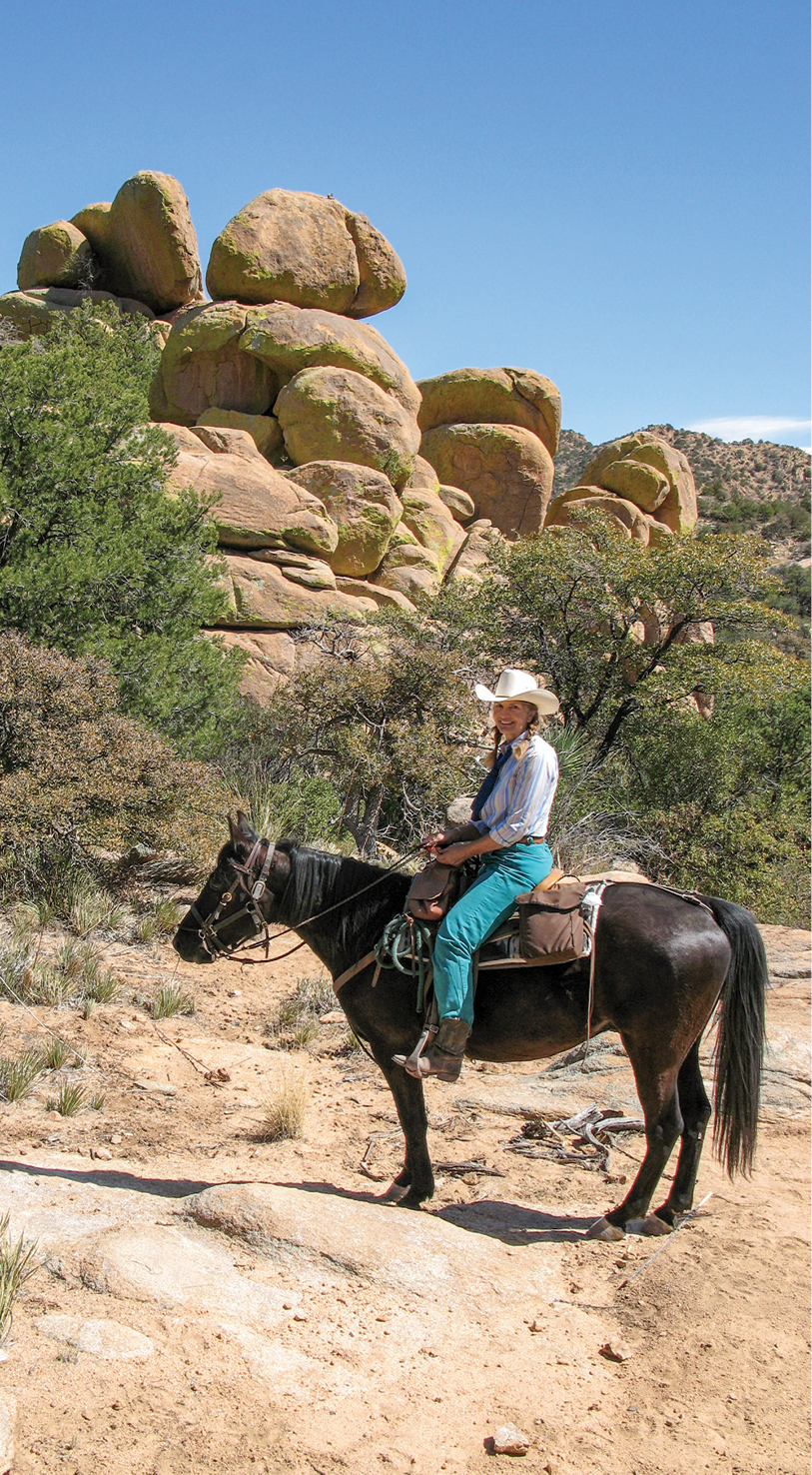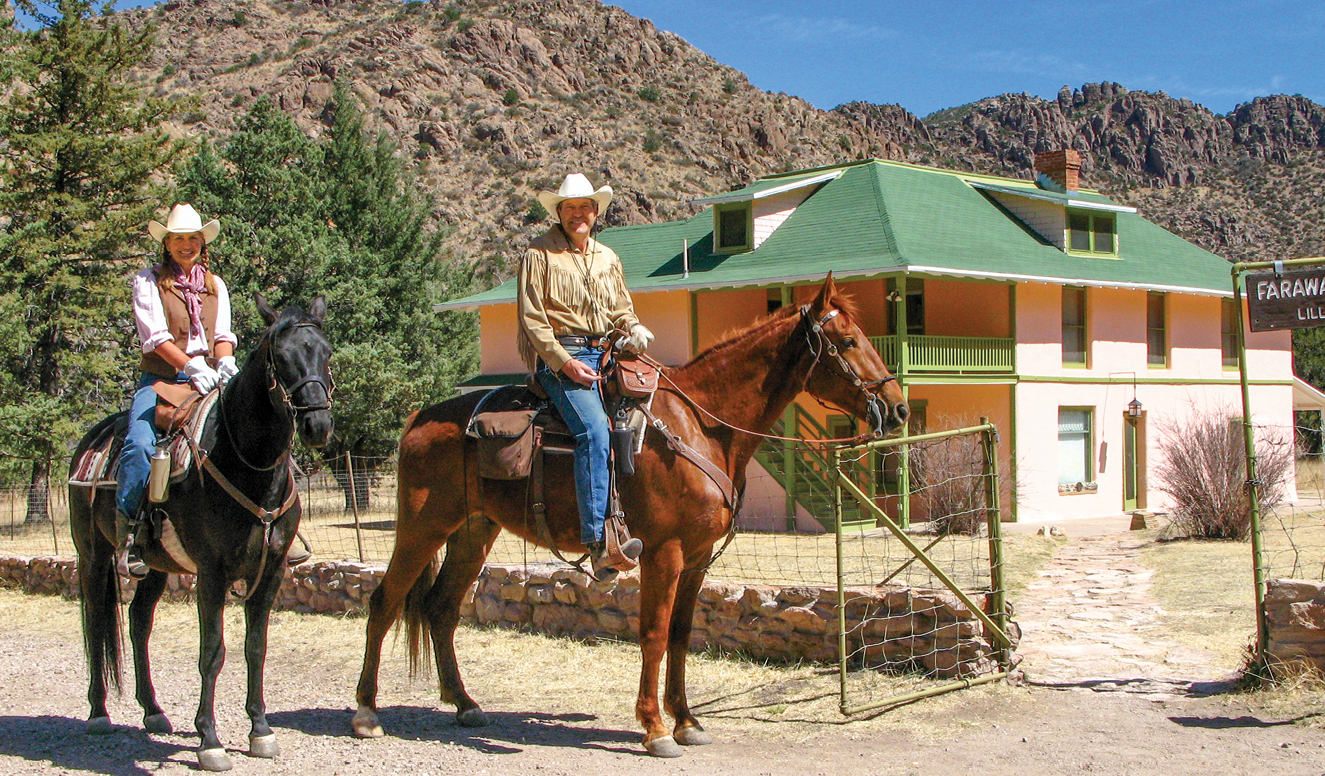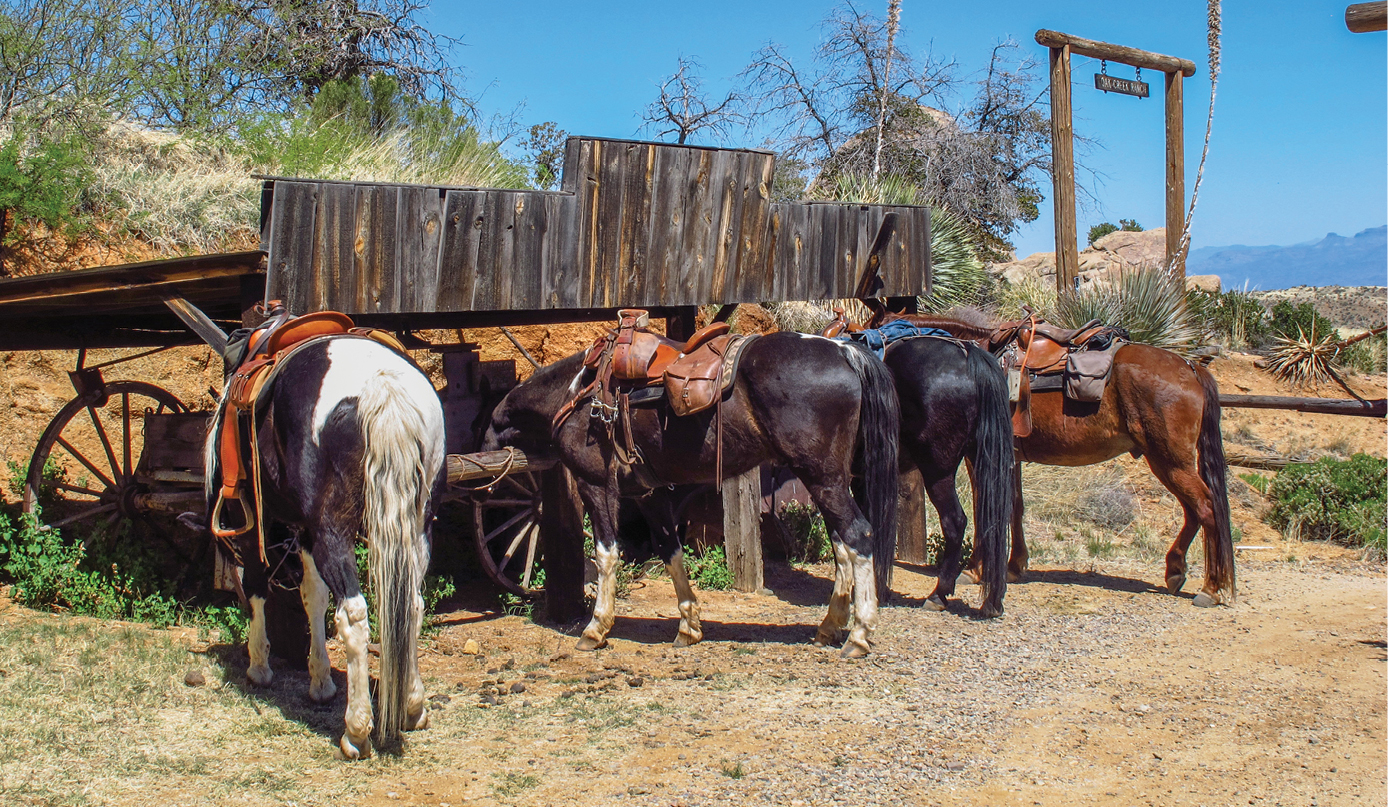For gorgeous trail riding in country steeped in Western history, head to southeast Arizona. This corner of the state offers a diverse landscape of golden grasslands and island mountain ranges, all waiting to be explored. Ride through pages right out of Western novels, from the gunfight at the OK Corral to Cochise’s hideout to the land of Geronimo.
Here’s our from-the-saddle guide to southeast Arizona’s top trails and equestrian accommodations.
Tombstone
We first trailered our Missouri Fox Trotter geldings to Tombstone Livery Stable (tombstonelivery.com), located about 3 miles north of Tombstone. Owners Doug and Terri Evans will fill you in on local history and give you trail-riding maps.
Tombstone was the site of the famous gunfight at the OK Corral.Our first journey was a ride to the monument of Al Schieffellin, the man responsible for Tombstone. Schieffellin made the silver strike that brought prospectors to the area, which created the town.
Using Doug and Terri’s map, we found Schieffellin’s Monument. He wished to be buried in a spot overlooking his early prospecting days.

A short distance south is Tombstone Monument Ranch (tombstone
monumentranch.com). This is the place to go if you don’t have your own horse. This Old West-style guest ranch offers lodging, food, trail riding, and evening entertainment.
Our favorite ride in this area lies along the San Pedro River. Trailer 6 miles from Tombstone Livery to the Fairbanks parking lot located next to the river. This lot is spacious enough to turn and park large trailers.
At the start of the trail, several buildings remain from the ghost town of Fairbanks that flourished between 1879 and 1888. Here, you can ride to the town’s old cemetery, just after the start of the trail on the right.
Next we rode down a wash, then north along the San Pedro River. This ride is gorgeous! If you’re short on time, ride the shorter loop that meanders through the trees along the river. For a longer ride, continue along the river to the stonework ruins of a mill and the site of the town of Contention.
Our last ride in Tombstone was to the site of the gunfight at the OK Corral. Downtown Tombstone is closed to vehicular traffic, but is open to stagecoaches and horse-drawn wagons. If you don’t want to provide entertainment for tourists, be sure your horse is used to this kind of confusion.

Lazy Horse Ranch
We trailered to our next riding location, Lazy Horse Ranch near Pearce (lazyhorseranch.com), a good base of operations to explore nearby rides. Owners Charles and Ann Supplee have a spare trailer for guest use so you can leave your trailer in camp.
For our first excursion, we trailered a short distance north and rode to the remains of the Fort Bowie National Historic Site. This area is steeped in history involving stage lines, Cochise, Geronimo, and the Apache Wars.
From highway 186, we drove a few miles on a good dirt road to Apache Pass, then on to the location of a wagon train massacre. Just after the sign for the massacre, look for a small parking spot on the right. From here, you can ride on the Butterfield Overland Mail stage route to the fort.

It was thrilling to ride the wagon route, enjoying vast views to the north. Eventually, we came to a trail junction, took a short jog to the left, and arrived at the ruins of a stage station.
Back on the main trail, we rode a short distance to the fort cemetery. It’s the resting place of a Medal of Honor recipient and one of Geronimo’s sons.
Riding beyond the cemetery we traveled through a small, lush canyon, past the original Fort Bowie (1862 to 1868) to the new Fort Bowie (1868 to 1894). You can tie your horse at a hitching rail in front of the visitor center and explore the ruins of the fort.
For the return ride, we took the trail behind the visitor center, which works its way up a ridge that offers far-reaching views in all directions. After coming off the ridge, before rejoining the trail near the stage-coach station ruins, take the canyon to the right, and ride it for at least a mile before turning around. This pretty, meandering canyon was also part of the Butterfield Overland Mail stage route.
We recommend a couple of other rides from Lazy Horse Ranch. For the first ride, trailer west a short distance to Cochise Stronghold, where Cochise was born and secretly buried. You’ll find a trail that leads uphill through forested mountains past boulder formations to the ridgetop that looks toward Tombstone.
Another good ride lies east of the ranch. Trailer to Chiricahua National Monument, enter the monument, and park in the trailer lot on your left. From here, you can ride up a shaded, forested valley and do a loop ride through boulder formations.
You’ll soon ride past the historic Faraway Guest Ranch that operated until the 1960s. In about 1.5 miles, you’ll cross the highway, continue across the parking lot by the visitor center, and pick the trail up on the far side.
After the parking lot, the trail travels 1.5 miles uphill where it comes to a 6.2-mile loop best
done counterclockwise.
Hay Creek Ranch
If you’d like to stay a while, head to Hay Creek Ranch in Oracle, north of Tucson (haycreekranch.net). Owners Doug and Jody Lindgren have created a horse camp where folks can spend months at a time. The camp has recreational-vehicle sites with full hookups. For riders, Hay Creek Ranch offers guest houses, laundry facilities, a restroom, and a community room. Equine amenities include covered corrals, a stable, an arena, and a tack room.
We stopped by the ranch to sample some riding and visit our good friends, Cole and Ann Younger, who were spending the winter at the ranch with their Missouri Fox Trotters.
Cole and Ann took us on a couple memorable rides from the Hay Creek Ranch. Our first ride was a 12-mile loop. Part of this loop follows the 800-mile Arizona Trail, a designated National Scenic Trail that stretches from Mexico to Utah. The Arizona Trail begins at the Coronado National Memorial near the United States-Mexico border, runs in and out of the Grand Canyon, and meets Utah in the Kaibab Plateau region. Our trail wound uphill and eventually came to High Jinks Ranch, a perfect place to tie up the horses, have a pack lunch, and do a little exploring.

Our next ride took us through varied desert country punctuated by saguaro cactus and canyons. In this open terrain, we’d meander off the trail and travel cross-country. (Doug and Jody will provide you with a trail map so you can explore your own routes.)
The next portion of this ride led through a canyon dotted with saguaro cactus. Saguaros can live 150 to 200 years. Cole and Ann led us to a crested saguaro perched on a canyon side. The uppermost branch ends of this type of cactus are flat, giving it an unusual appearance.
Hay Creek Ranch is located on a ridge with views in all directions. On our last night, we were treated to a gorgeous, ruby-red, Arizona sunset. After sundown, we all descended on The Hacienda, where we presented a slideshow of our horseback riding adventures. It was the maraschino cherry on top of a hot-fudge sundae!
Muleshoe Ranch
For a remote, private, peaceful experience, take a trip to the Muleshoe Ranch, owned by the Nature Conservancy (https://tinyurl.com/y9wpx2j4). The Muleshoe Ranch Cooperative Management Area is comprised of 49,120 acres of varied desert beauty and lush riparian areas. The Muleshoe covers most of the watershed of seven permanently flowing streams that represent the best remaining aquatic habitat in southeast Arizona.
An array of wildlife lives in the Muleshoe landscape. The area is visited by over 200 species of birds and is home to black bears, mountain lions, coyote, bobcats, ringtail cats, bighorn sheep, deer, and rabbits. Be on guard for rattlesnakes! This is a wildlife preserve, so rattlesnakes are protected. One large rattler took daily siestas on a step leading to the visitor center. We also watched snakes slitter by while soaking in the hot springs.
For history fans, this area was originally known as Hooker’s Hot Springs. In the 1993 film Tombstone, Charlton Heston played ranch owner Henry Hooker, who provided a place of rest for Wyatt Earp and his posse. Indeed, it’s still a restful place today.
Only Nature Conservancy members may stay at the Muleshoe Ranch. After you become a member, make reservations to secure a spot. To get there, you’ll drive 30 miles of mostly dirt road. It took us about 2 hours to drive in with our living-quarters trailer.

There are several casitas and cabins available to rent. The casitas are charming units built in the late 1880s. Each unit is fully equipped, with a kitchen, bath, furnishings, and linens. Natural hot-spring tubs are set outdoors for guests only. Nothing like a good soak after a long day in the saddle! There are large corrals with ample water available for your horse.
The ranch provides maps of several good trail rides. One loop was closed when we were there, so we rode farther up the incoming road past an old homestead and into an area with picturesque rock formations and small canyons filled with cottonwoods. For adventurous riding, we went off-trail for cross-country exploration.
We also rode the Beth Woodin scenic vista trail. This is a basic 7-mile loop, but in several places you can ride away from the loop, then return to create a longer riding day. To find this trail, take the road behind the casitas and go down the hill past the corrals; you’ll see a sign at the trailhead.
We did the loop clockwise. This route begins with a series of uphill switchbacks that offer panoramic views of the ranch and surrounding areas. At the top, we saw one of the few Gila monsters we’ve ever encountered. These elusive creatures live most of their life underground.
Most of this loop is open terrain, with features of both the Sonoran and Chiricahua deserts: juniper, mesquite, cacti, and an ocotillo forest. Near the end of this ride, the trail drops into a large wash. Follow the rock cairns back to the ranch, where your cozy cabin and soothing hot springs await.
SIDEBAR
Know Before You Go
Riding in the Arizona desert can be magical, but be prepared for the conditions. Here are our top tips for riding in the area.
Avoid the summer. The best time of year to ride in this area is fall through spring. Avoid the summer months, which can be sweltering.
Shoe your horse. Make sure your horse has good shoes or apply rugged hoof boots. Desert trails can be rocky and rough.
Be safe. Cell phones don’t get reception in much of this area. Let someone know where you plan to ride and when you plan to return.
Wear sunscreen. Wear sunscreen to protect your skin from the intense desert sun.
Hydrate your horse. Give your horse plenty of water before you head out for a ride. Water on the trails is usually scarce.
Stay hydrated. Make sure you stay hydrated, too. Drink water before each ride, and bring water on the trail.
Provide electrolytes. Your horse loses electrolytes (salt and other minerals) in his sweat. Provide him with electrolytes when you ride on hot days.
Watch for killer bees. There are Africanized honey bees in the area. Avoid disturbing their nests. If you’re attacked, run away as fast as you can. If you’re allergic to bees, carry a bee kit.
Watch for rattlesnakes. Rattlesnakes start coming out of dormancy in March, when overnight temperatures warm up to 50 degrees Fahrenheit. Watch for them on or near the trail.




